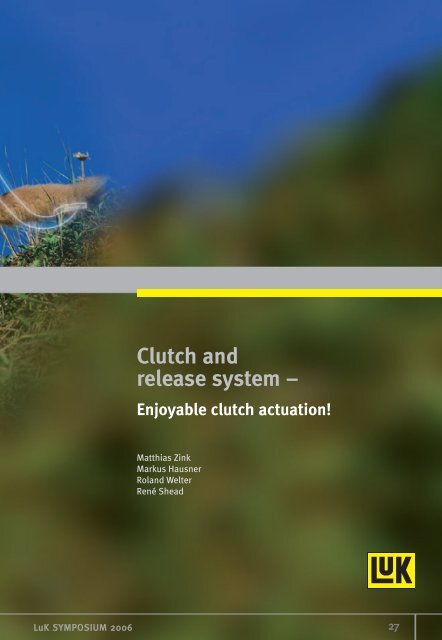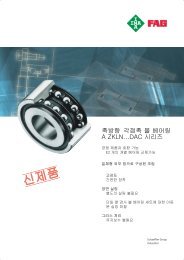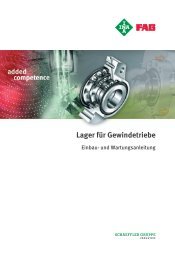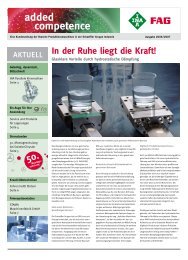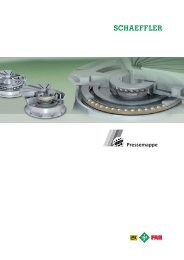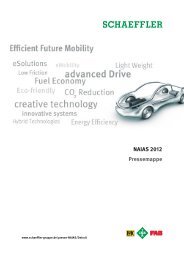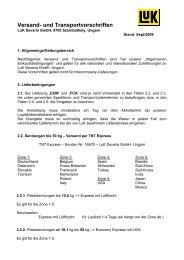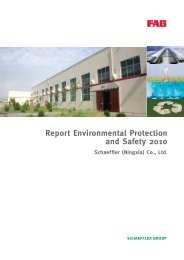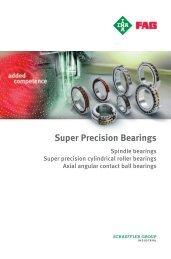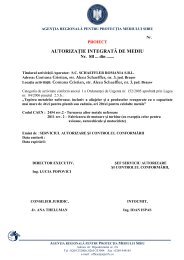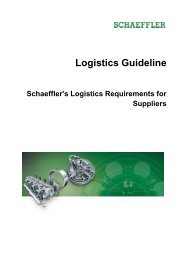You also want an ePaper? Increase the reach of your titles
YUMPU automatically turns print PDFs into web optimized ePapers that Google loves.
LuK SYMPOSIUM 2006<br />
<strong>Clutch</strong> <strong>and</strong><br />
<strong>release</strong> <strong>system</strong> –<br />
Enjoyable clutch actuation!<br />
Matthias Zink<br />
Markus Hausner<br />
Rol<strong>and</strong> Welter<br />
René Shead<br />
27
2 <strong>Clutch</strong> <strong>and</strong> <strong>release</strong> <strong>system</strong><br />
Introduction<br />
At the 1998 symposium, the phenomenon of<br />
increasing engine torque, primarily with diesel<br />
engines, as a result of new technologies (highpressure<br />
injection, supercharging) was discussed<br />
in connection with the modulation<br />
ability of increased <strong>system</strong>s [1]. The associated<br />
problem of clutch pedal load or pedal<br />
travel appeared at that time to have been<br />
solved for the long term by the self-adjusting<br />
clutch (SAC). A look at the maximum torque<br />
curve of a 2.0 liter diesel engine, however,<br />
shows that engine torques have risen by about<br />
40 % since 1998. This is due to the continued<br />
development of charging <strong>and</strong> injection technology<br />
(see Figure 1).<br />
As a result of this truly “high-performance”<br />
work from of our colleagues in engine development,<br />
even new <strong>and</strong> intelligent technologies<br />
such as reduced <strong>release</strong>-load selfadjusting<br />
clutches have been pushed to<br />
their limits within a relatively short period of<br />
time.<br />
The SAC, in combination with an over-center<br />
spring on the pedal, sets the st<strong>and</strong>ard with<br />
regard to good operating load levels for clutch<br />
Figure 1 Development of maximum engine torque over time, 2.0 liter diesel<br />
<strong>system</strong>s currently used in production. The<br />
pedal load that can presently be achieved is<br />
shown in Figure 2 as a function of engine<br />
torque. This analysis is based on a high number<br />
of measured vehicles. The range of variation<br />
is due, among other things, to different<br />
operating travels, together with correspondingly<br />
varying ratios in the <strong>release</strong> <strong>system</strong>. The<br />
target range for the maximum pedal load is<br />
90 N to 110 N. As a result, the SAC, in combination<br />
with an over-center spring, can cover<br />
applications up to approximately 300 Nm without<br />
compromise.<br />
In order to provide the driver with a comfortable<br />
pedal load, even with high engine torques, it is<br />
no longer possible to restrict ourselves to innovations<br />
within the clutch alone. New approaches<br />
must be found by considering the entire<br />
clutch/actuation <strong>system</strong>.<br />
Modulating <strong>and</strong><br />
operating work –<br />
state of the art<br />
In terms of ergonomics <strong>and</strong> comfort, any<br />
amount of work required from the driver is<br />
contrary to driver desire. Unlike automatic<br />
28 LuK SYMPOSIUM 2006
Figure 2 Achievable maximum pedal load in today's <strong>system</strong>s as a function of engine torque<br />
transmissions, this work cannot be arbitrarily<br />
avoided or reduced in a manual transmission,<br />
since the driver must be able to modulate<br />
the flow of torque between the engine <strong>and</strong><br />
transmission, <strong>and</strong> this modulation is supported,<br />
to a certain degree, by the work.<br />
The work on the pedal required from the driver to<br />
disengage the clutch is currently, depending<br />
upon application, between six <strong>and</strong> twelve joules<br />
(mean value without friction). For example, an<br />
application with 300 Nm requires eight joules<br />
(Figure 3).<br />
In the first approximation, there is empirically a<br />
proportional relationship between the operating<br />
work <strong>and</strong> the maximum pedal load. In order<br />
to identify the optimization potential of the<br />
operating work, its composition must first be<br />
analyzed. The following consideration assumes<br />
an infinitely stiff clutch cover <strong>and</strong> a frictionless<br />
<strong>system</strong>.<br />
The work required to compress the cushion<br />
spring corresponds to the area below the<br />
cushion spring characteristic curve <strong>and</strong> will<br />
be considered as the 100 % reference value<br />
(Figure 4). At an engine torque of 300 Nm,<br />
LuK SYMPOSIUM 2006<br />
<strong>Clutch</strong> <strong>and</strong> <strong>release</strong> <strong>system</strong> 2<br />
Figure 3 Operating work on the clutch pedal, based on the<br />
300 Nm example application<br />
29
2 <strong>Clutch</strong> <strong>and</strong> <strong>release</strong> <strong>system</strong><br />
this work corresponds<br />
to about<br />
1,0 J. This work is<br />
required so that<br />
the driver can modulate<br />
the torque<br />
transmitted by the<br />
clutch. Therefore<br />
the clutch disc must<br />
not be infinitely<br />
stiff, otherwise only<br />
a digital torque<br />
transfer would be<br />
possible.<br />
So that the clutch<br />
cannot be engaged,<br />
but rather disengaged<br />
by the driver,<br />
the cushion spring<br />
work, as is known, is<br />
done by an energy<br />
accumulator in the<br />
form of a spacesaving<br />
diaphragm<br />
spring. The work<br />
required from the<br />
driver to <strong>release</strong> the<br />
clutch disc is, therefore,<br />
the resultant<br />
of the diaphragm<br />
<strong>and</strong> cushion springs.<br />
Work must also be<br />
done to provide<br />
clearance<br />
clutch disc.<br />
to the<br />
In a conventional<br />
clutch, the diaphragm<br />
spring curve is<br />
made flat to avoid<br />
too great an increase<br />
in work over its<br />
service life. That<br />
means an operating<br />
work on the pressure<br />
plate in the order of<br />
800 % for the new<br />
condition, rising to about 1000 % as wear<br />
increases.<br />
Without the operating point displacement<br />
due to facing wear, the diaphragm spring<br />
characteristic can be approximated to the<br />
Figure 4 Torque transfer <strong>and</strong> modulating work in a normally open clutch<br />
Figure 5 Work required to disengage the normally closed clutch (SAC)<br />
Figure 6 Load <strong>and</strong> travel on the diaphragm spring fingers<br />
curve of the cushion spring characteristic,<br />
which reduces the disengagement work<br />
required at the pressure plate. This principle<br />
was put into practice with the SAC, introduced<br />
by LuK in 1994. As a result of the load-<br />
30 LuK SYMPOSIUM 2006
controlled adjusting mechanism, the operating<br />
point remains approximately constant,<br />
which can significantly reduce the work<br />
required (as compared to a conventional<br />
clutch in the new condition) to about 640 %<br />
(Figure 5) with no significant increase over<br />
the service life. This notably increases the<br />
advantage of an SAC over a conventional<br />
clutch.<br />
Irrespective of whether a conventional clutch<br />
or an SAC is used, levers are required to<br />
operate the diaphragm spring. In today's<br />
diaphragm spring clutches, these are realized<br />
in the form of diaphragm spring fingers<br />
(Figure 6). This design is favorable with<br />
regard to cost <strong>and</strong> installation space, but unfavorable<br />
with regard to stiffness <strong>and</strong> the associated<br />
travel losses during disengagement.<br />
This raises the work required to disengage an<br />
SAC to approximately 720 %. An application<br />
with 300 Nm thus requires approximately<br />
7,2 joules to disengage the clutch.<br />
There are additional stiffness losses in the<br />
<strong>release</strong> <strong>system</strong>. The work required from the<br />
driver to disengage an SAC finally increases to<br />
approximately 800 %, with reference to the<br />
energy stored by the cushion spring <strong>and</strong><br />
required to ensure the torque transfer (Figure 7).<br />
Figure 8 Composition of the operating work in an SAC clutch <strong>system</strong><br />
LuK SYMPOSIUM 2006<br />
<strong>Clutch</strong> <strong>and</strong> <strong>release</strong> <strong>system</strong> 2<br />
Figure 7 Loads <strong>and</strong> travels on the clutch pedal<br />
As already shown in Figure 3, this corresponds<br />
to 8,0 joules for an application with<br />
300 Nm.<br />
31
2 <strong>Clutch</strong> <strong>and</strong> <strong>release</strong> <strong>system</strong><br />
The composition of<br />
the work required to<br />
disengage the SAC as<br />
described above is a<br />
typical example of the<br />
state of the art. These<br />
<strong>system</strong>s have certainly<br />
reached a high<br />
st<strong>and</strong>ard as a result of<br />
the developments in<br />
the past several<br />
years. Nevertheless, it<br />
can be presumed that<br />
there still remains significant<br />
potential to<br />
be exploited, considering<br />
the fact that<br />
stiffness losses still<br />
account for some<br />
20 % of the total operating<br />
work (Figure 8).<br />
These losses can be<br />
reduced by a thorough<br />
optimization of<br />
the individual components<br />
on the one<br />
h<strong>and</strong> <strong>and</strong> by a consideration<br />
of the <strong>system</strong><br />
as a whole on the<br />
other.<br />
Figure 9 Coil spring clutch<br />
Reducing losses<br />
through component<br />
optimization<br />
As shown in Figure 8, approximately half of the<br />
losses can be traced to the stiffness of the<br />
diaphragm spring fingers, through which 10 % of<br />
the work required on the clutch pedal is caused. The<br />
next obvious step is to study this component on its<br />
own with respect to possible optimization potential.<br />
The introduction of the diaphragm spring clutch<br />
in 1962 appeared to bring nothing but benefits.<br />
Springs could be designed with low space<br />
requirements with nearly constant load <strong>and</strong> high<br />
clamp loads.<br />
In the diaphragm spring clutch, the diaphragm<br />
spring is used both to generate the clamp load<br />
<strong>and</strong> for operation. The thickness of the<br />
diaphragm spring also essentially defines the<br />
stiffness of the spring fingers <strong>and</strong> thus the stiffness<br />
of the operation.<br />
That functionality was clearly separated in the<br />
coil spring clutch (Figure 9).<br />
The conflicting aims of clamp load <strong>and</strong> operating<br />
stiffness can also be resolved with the<br />
diaphragm spring clutch. LuK has studied several<br />
possibilities in this regard.<br />
Machined load ring<br />
By “weakening” the load ring, it is possible to create<br />
diaphragm springs with high finger stiffness.<br />
This makes it possible to increase the thickness of<br />
32 LuK SYMPOSIUM 2006
Figure 10 Diaphragm spring with machined load rings<br />
the diaphragm spring by 50 % whilst maintaining<br />
a comparable clamp load characteristic (Figure 10).<br />
Reinforced diaphragm<br />
spring<br />
Reinforcing elements can be added to increase<br />
the bending stiffness of the diaphragm spring.<br />
Consequent application of this approach yields<br />
an 80 % increase in stiffness (Figure 11).<br />
Figure 11 Diaphragm spring with additional elements<br />
Diaphragm spring design<br />
Here, the thickness of the diaphragm spring is<br />
optimized with respect to operating stiffness<br />
(Figure 12). FE optimization tools are used to<br />
define the geometry of the load ring to generate<br />
the desired clamp load curve. With this method,<br />
LuK SYMPOSIUM 2006<br />
<strong>Clutch</strong> <strong>and</strong> <strong>release</strong> <strong>system</strong> 2<br />
Figure 12 Geometrically optimized diaphragm spring<br />
the thickness of a diaphragm spring can easily<br />
be doubled whilst maintaining a comparable<br />
clamp load characteristic.<br />
Reducing losses<br />
through <strong>system</strong><br />
optimization<br />
An extensive examination of the entire clutch<br />
<strong>and</strong> operation <strong>system</strong> can reveal weaknesses,<br />
which can then be eliminated through an<br />
improved design in future developments.<br />
In addition to the traditional tuning cycle<br />
approach, LuK is increasingly using simulationsupported<br />
optimization methods. One method<br />
used is statistical test plan calculation. The<br />
procedure used here is described in detail in<br />
the article “Simulation Using the DMFW Example”<br />
[1].<br />
Using this method, optimized results can be<br />
achieved through many small changes, <strong>and</strong> general<br />
trends can be deduced. One example of this<br />
is the<br />
“loss reduction through stiffness reduction”<br />
of a hydraulic <strong>release</strong> <strong>system</strong>. This is an apparent<br />
contradiction that requires closer consideration<br />
before it can be understood.<br />
A common representation of the stiffness of<br />
the <strong>release</strong> <strong>system</strong> components is the connection<br />
between volume expansion <strong>and</strong> pressure.<br />
Figure 13 is a schematic representation of the<br />
33
2 <strong>Clutch</strong> <strong>and</strong> <strong>release</strong> <strong>system</strong><br />
test setup for determining<br />
this characteristic<br />
<strong>and</strong> the typical<br />
method of<br />
expression for this<br />
result, using the<br />
example of a concentric<br />
slave cylinder<br />
(CSC). This procedure<br />
is certainly correct<br />
for describing the<br />
individual components,<br />
but is not<br />
entirely suitable for<br />
the complete <strong>system</strong>.<br />
This is because<br />
only the relation<br />
between the travel<br />
loss on the pedal<br />
<strong>and</strong> the <strong>release</strong> load<br />
of the clutch is important here.<br />
The volume expansion of the master <strong>and</strong> slave<br />
cylinder is significantly influenced, among other<br />
things, by the dynamic seal.<br />
In the depressurized state there is free distance<br />
between the seal <strong>and</strong> cylinder wall. This can be<br />
calculated from the area marked in red in Figure<br />
14 multiplied by the seal length. When the<br />
cylinder is subjected to pressure, this free volume<br />
is first taken up by the seal. Thus the oil<br />
displaced represents a loss. As the seal itself<br />
can be considered virtually incompressible, a<br />
proportional relationship between the volume<br />
expansion <strong>and</strong> the seal length can be presumed.<br />
It follows, therefore, that an increase in the<br />
piston area will lead to an increase in the vol-<br />
Figure 13 Measurement of the volume expansion of <strong>release</strong> <strong>system</strong> components<br />
Figure 14 Volume expansion of a concentric slave cylinder (CSC) as an example<br />
ume expansion. Thus the stiffness of the master<br />
<strong>and</strong> slave cylinders is first decreased in the<br />
usual representation <strong>and</strong> the volume expansion<br />
raised (Figure 15). It would be a mistake<br />
to conclude that this is also accompanied by<br />
increased loss for the <strong>system</strong> as a whole, as is<br />
shown below.<br />
The initial parameter for the overall <strong>system</strong> is<br />
not the pressure, but the <strong>release</strong> load of the<br />
clutch. When the surface area is increased, the<br />
<strong>system</strong> pressure drops as a result. The advantage<br />
remains unclear as long as we only<br />
consider the volume expansion. If, on the<br />
other h<strong>and</strong>, we do not consider the volume<br />
expansion as a function of the <strong>system</strong> pressure,<br />
but the travel loss as a function of the<br />
<strong>release</strong> load, we find a significant advantage<br />
(Figure 16).<br />
34 LuK SYMPOSIUM 2006
Figure 15 Increased volume expansion with increased<br />
piston area<br />
This finding has already been verified using<br />
prototypes. Based on a <strong>system</strong> that is usual for<br />
today (master cylinder area = 285 mm², slave<br />
cylinder area = 775 mm²) the cylinder areas<br />
were increased by 30 % as an example (master<br />
cylinder area = 380 mm², slave cylinder area =<br />
1025 mm²). As a result of this step, the travel<br />
loss on the clutch pedal was reduced by 30 %<br />
from 25 mm to 17 mm with a <strong>release</strong> load of<br />
2000 N (Figure 16). A remarkable improvement<br />
based on an overall consideration of clutch <strong>and</strong><br />
operation.<br />
This highlights a decade-old error – one made<br />
even by the experts.<br />
The usual surface areas of the master <strong>and</strong><br />
slave cylinders today arose largely from the<br />
st<strong>and</strong>ardized size of the brake cylinder. Those,<br />
however, must now be called into question<br />
<strong>and</strong> possibly redefined in light of this new<br />
finding.<br />
Figure 16 Relationship between pedal travel loss <strong>and</strong> <strong>release</strong> load<br />
LuK SYMPOSIUM 2006<br />
Measures for<br />
reducing operating<br />
load<br />
The first <strong>and</strong> also obvious approach was<br />
described in the previous section – optimizing<br />
the existing <strong>system</strong>. From what is known today,<br />
this potential can be used to reduce the operating<br />
loads by about 10 % to 15 %, so that engine<br />
torques up to 350 Nm can be covered with<br />
acceptable pedal travels <strong>and</strong> loads. Over <strong>and</strong><br />
above, further measures are necessary in order<br />
to be able to attain operating loads lower than<br />
110 N. There are a number of options for doing<br />
this, which are described in the following sections:<br />
• Work redistribution<br />
• Energy accumulators<br />
• Multi-plate clutch<br />
• External energy (active support)<br />
• <strong>Clutch</strong>-by-wire<br />
Work redistribution<br />
<strong>Clutch</strong> <strong>and</strong> <strong>release</strong> <strong>system</strong> 2<br />
In work redistribution, the total work remains<br />
constant <strong>and</strong> is merely distributed more favorably<br />
over the pedal travel. The principle is simple.<br />
The work should be increased where the pedal<br />
load is currently low, so that it can be reduced<br />
where the pedal load is currently high (Figure 17).<br />
Reduced-load clutches have in principle a<br />
strong “drop-off” in the <strong>release</strong> load characteristic<br />
because of the approximation of the<br />
diaphragm spring to the cushion spring curve. A<br />
35
2 <strong>Clutch</strong> <strong>and</strong> <strong>release</strong> <strong>system</strong><br />
Figure 17 Work redistribution in clutch operation<br />
dual effect can thus be achieved by this redistribution:<br />
the realization of a harmonic load characteristic<br />
<strong>and</strong> the reduction of the maximum<br />
pedal load.<br />
The technical solution is a variable ratio for<br />
clutch operation. At low pedal loads the ratio<br />
is reduced <strong>and</strong> at high pedal loads it is raised.<br />
A clutch <strong>system</strong> with clutch, hydraulics <strong>and</strong><br />
pedal provides three possibilities for variation.<br />
Installation space <strong>and</strong> tolerance sensitivity<br />
argue against a design implementation<br />
inside the clutch. At LuK, therefore, the “variable<br />
hydraulic ratio” <strong>and</strong> “variable pedal<br />
ratio” concepts are being pursued.<br />
Variable hydraulic ratio<br />
The hydraulic ratio is calculated from the<br />
slave to master cylinder area ratio. This<br />
means that the variability can be achieved<br />
by changing one of the two areas as a function<br />
of the piston stroke. Because of the tolerance<br />
<strong>and</strong> wear situation of the clutch <strong>system</strong>,<br />
Figure 18 Master cylinder with variable cross section<br />
implementation in the slave cylinder is not<br />
feasible. This is because the slave cylinder<br />
piston position does correspond to any specific<br />
clutch position. For this reason, LuK is<br />
developing a master cylinder with a variable<br />
piston surface (Figure 18). A design with a<br />
moving primary seal <strong>and</strong> variable cylinder<br />
diameter is preferable, since the greatest<br />
pressure therefore occurs at the smallest seal<br />
gap. The risk of gap extrusion is therefore minimized.<br />
The advantages of the variable master cylinder<br />
include a relatively simple design with no additional<br />
components <strong>and</strong> neutral installation<br />
space requirements. Since the variability is<br />
achieved through the variable sealing gap, the<br />
design is limited. The spread (difference<br />
between the largest <strong>and</strong> smallest ratio) currently<br />
being tested is 14 %. Since the total work<br />
must remain constant, there is potential for a<br />
load reduction of about 7 %. Combined with the<br />
optimization measures described above, as<br />
well as a modified over-center spring, this solution<br />
can cover engine torques up to 400 Nm<br />
with pedal loads less than 110 N.<br />
Variable pedal ratio<br />
For engine torques greater than 400 Nm, a<br />
variable pedal ratio (VPR) is a very promising<br />
approach. The principle is the same as that in<br />
the previous section, but more work can be<br />
redistributed with a mechanical design with a<br />
possible spread of up to 60 %. The potential for<br />
load reduction is thus approximately 30 %,<br />
because of which, applications up to 500 Nm<br />
can be covered.<br />
36 LuK SYMPOSIUM 2006
Figure 19 <strong>Clutch</strong> pedal with variable ratio<br />
Figure 19 shows a production drawing for this<br />
solution. The <strong>system</strong> consists of two rollers<br />
mounted on the pedal <strong>and</strong> one piston rod permanently<br />
connected to a coulisse track. When<br />
the clutch pedal is operated, the rollers follow<br />
Figure 20 Relationship between coulisse track <strong>and</strong> pedal ratio<br />
LuK SYMPOSIUM 2006<br />
<strong>Clutch</strong> <strong>and</strong> <strong>release</strong> <strong>system</strong> 2<br />
the coulisse track, with each of the two rollers<br />
able to support a load that is perpendicular to<br />
the track (Figure 20). The function lines fR1 <strong>and</strong><br />
fR2 of these two loads <strong>and</strong> the function line fK of the piston load intersect in the load<br />
center of the <strong>system</strong>. The parallel distance<br />
lH(sP) from function line fK to the pedal rotational<br />
axis determines the lever arm <strong>and</strong> thus<br />
the ratio of the clutch pedal as a function of<br />
pedal travel sP. Through the design of the coulisse, any ratio<br />
curve is possible as a function of pedal travel.<br />
There are, however, design limitations in the<br />
form of the piston cross forces, surface pressure<br />
<strong>and</strong> <strong>system</strong> stiffness.<br />
Figure 21 shows a measurement of a functional<br />
example. The original maximum pedal<br />
load of 200 N <strong>and</strong> drop-off of 100 N could be<br />
reduced by this <strong>system</strong> to 160 N <strong>and</strong> 40 N<br />
respectively.<br />
A favorable side effect of the flatter pedal load<br />
curve is a likewise flatter clutch torque characteristic<br />
curve between the engagement point<br />
<strong>and</strong> approximately 100 Nm. This is because a<br />
greater ratio acts in this range like one of a<br />
comparable non-variable <strong>system</strong>. The result is<br />
improved clutch modulation capability in the<br />
lower torque range (traffic jam or maneuvering<br />
operations).<br />
37
2 <strong>Clutch</strong> <strong>and</strong> <strong>release</strong> <strong>system</strong><br />
Figure 21 Pedal load measurement with <strong>and</strong> without variable<br />
pedal ratio<br />
The complexity of the variable pedal ratio <strong>system</strong><br />
is higher than that of the variable<br />
hydraulic ratio <strong>system</strong>. Additional components<br />
are unavoidable <strong>and</strong> the installation<br />
space requirements at the pedal interface<br />
increased. In order to keep these requirements<br />
to a minimum, the version developed<br />
by LuK is largely integrated in the master<br />
cylinder. In the design shown in Figure 19,<br />
only a second fastening pin is required on the<br />
pedal side.<br />
Energy accumulator<br />
Energy accumulators are charged at low pedal<br />
loads <strong>and</strong> <strong>release</strong> their energy in areas of high<br />
pedal loads. In today's <strong>system</strong>s, this principle is<br />
already frequently used on the pedal in the form<br />
of an over-center spring. The advantage of overcenter<br />
springs is that they are already charged<br />
<strong>and</strong> pre-stressed before the <strong>system</strong> is actuated.<br />
This not only redistributes the operating work<br />
required from the driver, but also reduces it.<br />
Over-center springs always have a symmetrical<br />
characteristic curve with respect to the crossover<br />
point, which means that limitations are<br />
already placed on the pedal load correction.<br />
Two-stage characteristic curves, especially in<br />
combination with the SAC characteristics, are a<br />
further development (Figure 22). It has enabled<br />
even critical applications to be configured comfortably.<br />
Figure 22 Pedal load curves with one- <strong>and</strong> two-stage overcenter<br />
spring<br />
These <strong>system</strong>s reach their limits with increased<br />
engine torque. As mentioned at the start, a pedal<br />
load of less than 110 N can hardly be realized<br />
with an engine torque of 350 Nm <strong>and</strong> above.<br />
LuK is therefore studying alternatives. Again<br />
here, the clutch <strong>system</strong> offers three possible<br />
installation positions: the clutch, the<br />
hydraulic <strong>system</strong> <strong>and</strong> the pedal assembly.<br />
Integration into the hydraulic <strong>system</strong> would<br />
only be possible with an extensive reconfiguration.<br />
LuK is therefore pursuing the following<br />
solutions: “<strong>Clutch</strong> with servo spring” <strong>and</strong><br />
“Pedal assembly with leaf spring, roller <strong>and</strong><br />
coulisse.”<br />
<strong>Clutch</strong> with servo spring<br />
The integration of an independent servo spring<br />
in the clutch provides a potential pedal load<br />
reduction of up to 20 N. However, all the tolerances<br />
of the diaphragm spring finger height<br />
<strong>and</strong> clutch wear lead to significant variation in<br />
the level of load <strong>and</strong> load characteristic.<br />
38 LuK SYMPOSIUM 2006
Figure 23 Design <strong>and</strong> operating principle of the servo spring<br />
Figure 24 Energy accumulator with leaf spring, roller <strong>and</strong> coulisse<br />
LuK SYMPOSIUM 2006<br />
<strong>Clutch</strong> <strong>and</strong> <strong>release</strong> <strong>system</strong> 2<br />
Pedal assembly with leaf spring,<br />
roller <strong>and</strong> coulisse<br />
In this <strong>system</strong>, a leaf spring, one end of which<br />
has a fixed connection to the pedal box, serves<br />
as an energy accumulator (Figure 24). The free<br />
end has a roller bearing that presses on a<br />
coulisse fixed to the pedal. The required torque<br />
about the pedal rotation point is therefore generated.<br />
This <strong>system</strong> offers a number of advantages compared<br />
to the conventional over-center spring:<br />
• Any assistance characteristic is possible<br />
• Preload independent of assistance load<br />
• Push-pull-push possible<br />
With the over-center springs used today, only<br />
one reversal of load direction is possible.<br />
Before the cross over point, the over-center<br />
spring generates a positive load to return the<br />
pedal <strong>and</strong> after the cross over point a negative<br />
load to reduce the pedal load. In the spring <strong>system</strong><br />
presented here, the load direction can in<br />
principle be reversed any number of times<br />
(push-pull-push function, Figure 24). So in case<br />
of insufficient return load with the pedal in the<br />
down position, the load can be increased<br />
accordingly.<br />
Measurements with functional samples produced<br />
good results with a clear gain in perform-<br />
39
2 <strong>Clutch</strong> <strong>and</strong> <strong>release</strong> <strong>system</strong><br />
ance compared to the over-center springs used<br />
today. In the example shown in Figure 24, the<br />
maximum pedal load is reduced by 65 N whilst<br />
achieving the desired return load of 15 N. It is<br />
worth noting that the operation is virtually frictionless<br />
(low hysteresis increase).<br />
This concept can be used to cover applications<br />
up to 500 Nm with a desired pedal load of 110 N.<br />
Design limits are set by the permissible stresses<br />
in the leaf spring <strong>and</strong> the surface pressure<br />
between the roller bearing <strong>and</strong> coulisse track.<br />
Multi-plate clutch<br />
By multiplying the number of friction surfaces,<br />
the multi-plate clutch is able to reduce the operating<br />
load. In a twin-plate clutch, for instance,<br />
the operating load can be lowered by 40 % with<br />
the same moment of transmission. Some of the<br />
benefit is lost in ensuring the separation of the<br />
two clutch plates.<br />
In addition to the load benefits, the multi-plate<br />
clutch also provides improved thermal capacity<br />
<strong>and</strong> the potential to reduce the diameter of the<br />
clutch. About 20 mm more axial installation<br />
space is required.<br />
LuK now has several twin-plate clutches in<br />
st<strong>and</strong>ard production for engine torques above<br />
500 Nm. These clutches all take advantage of<br />
the proven SAC technology.<br />
Figure 25 Design <strong>and</strong> characteristic curves of a twin-plate SAC<br />
External energy to<br />
reduce pedal loads<br />
Passive <strong>system</strong>s are limited based on their<br />
efficiency. LuK currently believes that a pedal<br />
load of 110 N can be achieved with engine<br />
torques up to 500Nm using the current passenger<br />
car sector pedal travels (120 ... 160 mm)<br />
<strong>and</strong> clutch dimensions. For applications above<br />
500 Nm for which a twin-plate clutch cannot<br />
be used, there is the option of actively supporting<br />
the clutch pedal in a manner similar to<br />
power-assisted steering. In order to make the<br />
expense of an active <strong>system</strong> pay off, LuK currently<br />
envisages the following application<br />
areas:<br />
• Required pedal loads below 110 N<br />
for applications between 400 Nm<br />
<strong>and</strong> 500 Nm<br />
• Applications above 500 Nm<br />
• Shortening pedal travel/redefining<br />
ergonomics<br />
• Applications outside the automotive<br />
sector (e.g., commercial vehicles,<br />
tractors)<br />
• Retrofits<br />
• Optional equipment<br />
40 LuK SYMPOSIUM 2006
LuK has studied a number of possible versions<br />
<strong>and</strong> configurations for active support with the<br />
following development goals:<br />
• Self-contained, easily adaptable unit<br />
• Low interface requirements (add-on)<br />
• Function independent of other components<br />
(e.g., combustion engine)<br />
• Differentiation from clutch-by-wire<br />
• Maintaining a direct connection between<br />
clutch <strong>and</strong> pedal<br />
These requirements are met in the electrohydraulic<br />
CSA (<strong>Clutch</strong> Servo Assistance) <strong>system</strong><br />
developed by LuK. This is a pump unit driven by<br />
an electric motor positioned directly between<br />
the slave <strong>and</strong> master cylinder (Figure 26).<br />
Figure 26 <strong>Clutch</strong> servo assistance (CSA) – arrangement in<br />
the overall <strong>system</strong><br />
This unit consists of an electric motor, electronics<br />
<strong>and</strong> hydraulic <strong>system</strong>. The electronics are for<br />
monitoring only <strong>and</strong> protect the <strong>system</strong> from<br />
overload (temperature, current). They are not<br />
required for the actual function of the unit.<br />
The hydraulic <strong>system</strong> (Figure 27) consists of an<br />
internal gear pump, a regulating valve <strong>and</strong> a<br />
LuK SYMPOSIUM 2006<br />
Figure 27 Hydraulic <strong>system</strong> of the CSA<br />
<strong>Clutch</strong> <strong>and</strong> <strong>release</strong> <strong>system</strong> 2<br />
safety valve, which ensures clutch operation<br />
under all conditions.<br />
The <strong>system</strong> has five possible operating modes:<br />
Sleep Electronics <strong>and</strong> electric<br />
motor not powered<br />
St<strong>and</strong>-by Electronics powered, electric<br />
motor not powered<br />
Pump turning Regulating valve open<br />
Pump turning Regulating valve at<br />
operating point<br />
Emergency Safety valve operation<br />
The <strong>system</strong> is in sleep mode when, for example,<br />
the ignition key is out. In this state, the entire<br />
<strong>system</strong> is inactive <strong>and</strong> without power. The <strong>system</strong><br />
therefore has no energy requirements <strong>and</strong><br />
no functionality.<br />
When there is a possible intention to operate,<br />
the <strong>system</strong> is in st<strong>and</strong>-by mode. This state may<br />
be defined by the presence of the ignition key<br />
in the ignition. The electronics are now active,<br />
but there is still no power to the electric<br />
motor.<br />
If the clutch pedal is operated from st<strong>and</strong>-by<br />
mode, the pump is driven by the electric<br />
motor. Up to a freely definable pressure<br />
threshold pS in the <strong>release</strong> <strong>system</strong>, there is no<br />
support, since the regulating valve is preloaded<br />
by a spring. The control edge is still<br />
completely open <strong>and</strong> the pump cannot build<br />
up pressure.<br />
When the pressure threshold pS is exceeded,<br />
pressure-proportional support is generated <strong>and</strong><br />
the <strong>release</strong> <strong>system</strong> is divided into pressure<br />
ranges: high pressure (pslave) <strong>and</strong> low pressure<br />
41
2 <strong>Clutch</strong> <strong>and</strong> <strong>release</strong> <strong>system</strong><br />
(pmaster) (Figures 28<br />
<strong>and</strong> 29). The proportionality<br />
is expressed<br />
as the reduction factor<br />
k <strong>and</strong> is determined<br />
by the area<br />
ratio A2:A1 of the regulating<br />
valve. If, for<br />
example, the goal<br />
is to bisect the pressure<br />
level above<br />
the start-up threshold<br />
pS in the master<br />
cylinder, then the<br />
result is a regulating<br />
valve surface ratio of<br />
A2:A1 = 1:2.<br />
In summary, the following equation characterizes<br />
the layout of the regulating valve:<br />
Through the pressure threshold p S <strong>and</strong><br />
reduction factor k parameters, the pedal load<br />
Figure 28 Pump turning, regulating valve at operating point (support)<br />
Figure 29 Measurement of the pedal load with <strong>and</strong> without CSA<br />
curve can be accurately corrected to two target<br />
values. Figure 29 shows an example of<br />
this. The target was to reduce the original<br />
250 N pedal load to 120 N with a subsequent<br />
drop in pedal load (drop-off) of 20 N. The<br />
target could be achieved with a switch-on<br />
threshold of 30 N (corresponds to a pressure<br />
threshold p S of 5 bar) <strong>and</strong> a reduction factor<br />
of 0,4.<br />
42 LuK SYMPOSIUM 2006
A rational alternative to the CSA would be, for<br />
example, a pump driven directly via the accessories.<br />
The benefit of this would be the elimination<br />
of the electric motor <strong>and</strong> electronics, making<br />
it possible to, amongst other things,<br />
significantly lower the <strong>system</strong> costs. The disadvantages<br />
include higher interface dem<strong>and</strong>s on<br />
other <strong>system</strong>s <strong>and</strong> the lack of functionality when<br />
the engine is not running.<br />
<strong>Clutch</strong>-by-wire<br />
In modern engines, the gas pedal is no longer<br />
mechanically linked to the throttle valve or the<br />
injection <strong>system</strong>. Instead there is just a sensor<br />
on the gas pedal that forwards the driver's comm<strong>and</strong>s<br />
to an actuator via a control device (electric<br />
gas pedal). This creates the possibility to<br />
adapt the engine characteristic as required to<br />
the driving situation. This is now a basic prerequisite<br />
for making optimal use of the potential of<br />
today's engines <strong>and</strong> ensuring a comfortable<br />
drive.<br />
A clutch-by-wire <strong>system</strong> promises comparable<br />
potential for the clutch (CBW, Figure 30). This<br />
is the entry-level version of the family of<br />
automated shift transmissions <strong>and</strong> represents<br />
the most complex version for clutch<br />
operation for the manual shift transmission.<br />
The CBW <strong>system</strong> eliminates the <strong>release</strong> <strong>system</strong><br />
as a fixed connection between the clutch<br />
<strong>and</strong> clutch pedal <strong>and</strong> uses a pedal travel sensor,<br />
a controller <strong>and</strong> an actuator to operate the<br />
clutch (Figure 30). The pedal operating load<br />
Figure 30 <strong>Clutch</strong>-by-wire (CBW)<br />
LuK SYMPOSIUM 2006<br />
<strong>Clutch</strong> <strong>and</strong> <strong>release</strong> <strong>system</strong> 2<br />
Figure 31 Development of the full load characteristic of a<br />
2.0 liter diesel engine<br />
can be chosen freely using a pedal spring or<br />
comparable mechanism. This makes an optimal<br />
layout possible regardless of the engine<br />
torque.<br />
In order to justify the high expenditure on<br />
hardware <strong>and</strong> software, a CBW <strong>system</strong> offers<br />
numerous possibilities for improving driving<br />
comfort. These include, in particular, slip control<br />
for vibration isolation between the engine<br />
<strong>and</strong> transmission, which is dealt with in the<br />
article “Software for Automated Transmissions”<br />
[1].<br />
In a similar manor to how the electric gas pedal<br />
adapts the engine characteristics, CBW can be<br />
used to adapt the torque characteristic of the<br />
clutch to the specific driving situation. An<br />
important example in this context is a launch<br />
process, which is influenced by the combination<br />
of engine torque <strong>and</strong> clutch torque. Figure<br />
31 shows how the full-load curve of a 2.0 liter<br />
diesel engine has changed over the years. In<br />
the idle speed range, the engines operate both<br />
then <strong>and</strong> now in induction mode, with the maximum<br />
engine torque practically unchanged at<br />
low speeds. By contrast, the maximum engine<br />
torques, <strong>and</strong> therefore also the clutch torques,<br />
have tripled over the years (see also Figure 1).<br />
As a result, a weak engine is combined with a<br />
strong clutch at low engine speeds (red area in<br />
Figure 31).<br />
This circumstance can be rectified with a CBW.<br />
Using information such as the engine <strong>and</strong><br />
43
2 <strong>Clutch</strong> <strong>and</strong> <strong>release</strong> <strong>system</strong><br />
transmission speeds, the clutch torque as a<br />
function of the pedal travel can be varied to<br />
best suit each <strong>and</strong> every driving condition.<br />
LuK has already installed CBW prototypes in<br />
several different vehicles <strong>and</strong> tested them. The<br />
launch performance has improved remarkably<br />
compared to conventional clutch <strong>system</strong>s as a<br />
result of the function just described.<br />
Summary<br />
Despite the large number of technical solutions<br />
presented here, the application areas of the<br />
different concepts can be clearly defined.<br />
The controlling parameters are the maximum<br />
engine torque <strong>and</strong> the desired maximum pedal<br />
load as shown in Figure 32. This should be<br />
viewed as a recommendation, which can vary<br />
depending on the philosophy of the vehicle<br />
manufacturer.<br />
Smaller steps can be achieved through the separate<br />
optimization of individual components. The<br />
Figure 32 Options <strong>and</strong> potential for reducing operating load<br />
correct technical solutions for the torque<br />
increases of the coming years can only be found<br />
with the correct dimensioning of the complete<br />
<strong>system</strong>.<br />
The complexity of the solutions for high torque<br />
applications may appear high at first. However,<br />
if the intension is to offer manual transmissions<br />
in this class, there is no alternative but to<br />
start with the total <strong>system</strong> development as<br />
soon as possible.<br />
In order to support this, LuK has put the prerequisites<br />
in place with a complete switch<br />
from a component supplier to a <strong>system</strong> supplier.<br />
This requires close cooperation between<br />
the clutch <strong>and</strong> chassis departments at the<br />
automobile manufacturers. Together with<br />
the automobile manufacturers, LuK will continue<br />
to present innovative solutions, which<br />
offer the end consumer optimal operating<br />
comfort despite significantly increased engine<br />
torques.<br />
44 LuK SYMPOSIUM 2006
Literature<br />
[1] Zink, M.; Shead, R.: <strong>Clutch</strong> <strong>and</strong> Actuation as<br />
a System, 6th LuK Symposium 1998.<br />
[2] Fidlin, A.; Seebacher, R.: Simulation Technology<br />
Using the DMFW Example, 8th LuK Symposium<br />
2006.<br />
[3] Küpper, K.; Serebrennikov, B.; Göppert, G.:<br />
Software for Automated Transmissions, 8th<br />
LuK Symposium 2006.<br />
LuK SYMPOSIUM 2006<br />
<strong>Clutch</strong> <strong>and</strong> <strong>release</strong> <strong>system</strong> 2<br />
45


